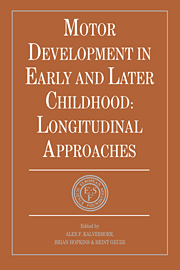Book contents
- Frontmatter
- Contents
- List of contributors
- Foreword
- Preface
- SETTING THE SCENE
- SECTION I BIOLOGICAL BASIS OF MOTOR DEVELOPMENT
- SECTION II DEVELOPMENT OF BODY POSTURE AND GOAL-DIRECTED REACHING
- SECTION III MOTOR DEVELOPMENT, EARLY COMMUNICATION AND COGNITION
- 9 Early interactional signalling: the role of facial movements
- 10 Motor development: communication and cognition
- 11 On faces and hands and the development of communication
- SECTION IV ACQUISITION OF SKILLS
- SECTION V MOTOR DEVELOPMENT AND HANDICAP
- SECTION VI METHODOLOGICAL AND CONCEPTUAL CONSIDERATIONS
- Epilogue: description versus explanation
- Index
11 - On faces and hands and the development of communication
from SECTION III - MOTOR DEVELOPMENT, EARLY COMMUNICATION AND COGNITION
Published online by Cambridge University Press: 05 May 2010
- Frontmatter
- Contents
- List of contributors
- Foreword
- Preface
- SETTING THE SCENE
- SECTION I BIOLOGICAL BASIS OF MOTOR DEVELOPMENT
- SECTION II DEVELOPMENT OF BODY POSTURE AND GOAL-DIRECTED REACHING
- SECTION III MOTOR DEVELOPMENT, EARLY COMMUNICATION AND COGNITION
- 9 Early interactional signalling: the role of facial movements
- 10 Motor development: communication and cognition
- 11 On faces and hands and the development of communication
- SECTION IV ACQUISITION OF SKILLS
- SECTION V MOTOR DEVELOPMENT AND HANDICAP
- SECTION VI METHODOLOGICAL AND CONCEPTUAL CONSIDERATIONS
- Epilogue: description versus explanation
- Index
Summary
In the past, motor, cognitive and communicative development were studied more or less in isolation from each other. Since the beginning of the 1970s these domains of development have become conceptually intertwined, particularly in the case of cognition and communication. Currently, it is widely assumed that processes involved in social interchanges during infancy provide a functional continuity with later cognitive achievements, particularly in terms of verbal abilities (Frye, 1989). With some notable exceptions, this assumption has generated little interest in the role of movement and posture in contributing to this functional continuity. This is a surprising neglect, given that, until words can be used to express a variety of functions, movements and postures serve not only as indexes of internal states but also as regulators of interpersonal communication. In these respects, motor development can be seen as a crucial catalyst that binds cognition and communication together into an inseparable whole during early childhood. The present section then is an attempt to redress some of this neglect, while at the same time drawing attention to movement patterns (facial expressions and pointing) that have been infrequently studied in an ontogenetic perspective.
ON FACES
Papoušek & Papoušek (Chapter 9, this volume) assign eight functions to facial movements, ranging from signs of behavioural and emotional states to their regulative role in the feeding situation. The possibility of being able to classify such a range of functions runs counter to the general observation that human infants are motorically altricial relative to the young of other primate species.
- Type
- Chapter
- Information
- Motor Development in Early and Later ChildhoodLongitudinal Approaches, pp. 166 - 173Publisher: Cambridge University PressPrint publication year: 1993



